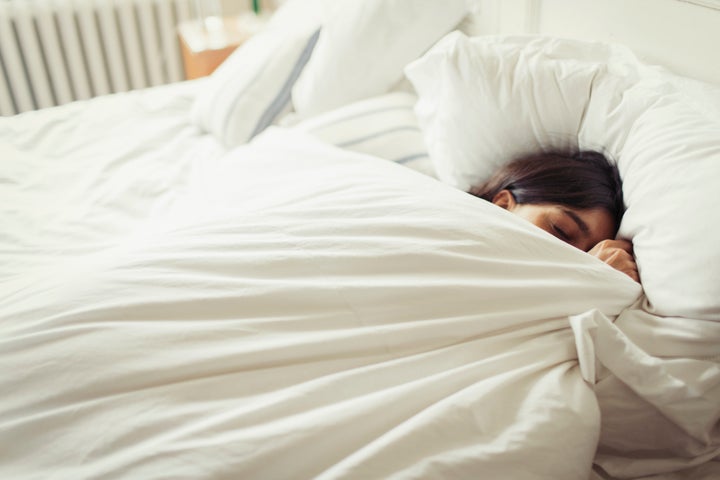Headaches are a pain that many of us have to deal with on a daily basis. While some pass by quickly, others can linger, causing people to miss out on social engagements, lag behind at work or just feel downright awful.
A headache is one of the most common complaints that a patient brings into a doctor’s office, according to William Chow, a neurologist based in Los Angeles. We know the obvious remedies ― such as popping an Advil or extra-strength Tylenol ― but what if you don’t want to rely on your medicine cabinet all the time?
HuffPost chatted with experts on some surprising causes of headaches as well as some lesser-known ways to relieve them. Take a look below:
1. Address your nightly teeth grinding

One of the most under-discussed causes of headaches is jaw tension and tooth grinding, said Boryana Nikolova, a dentist based in London. According to Nikolova, “70% of adults grind their teeth,” which usually occurs at night when people don’t realize they’re doing it.
“Tooth grinding places tension on the tiny muscles that control your jaw and these muscles are around the side of your head and around your temples,” Nikolova said, adding that this could lead to headaches, especially in the first few hours after you wake up.
This condition, known in the medial world as bruxism, can be helped by practicing relaxation techniques before bed, as stress may lead to nighttime grinding. If the condition is severe, Nikolova suggested making an appointment with your dentist who can provide you with a specially made mouthguard.
“The appliance acts as a shock absorber for any residual grinding so it does not damage your teeth or wear out the muscles around your head. It is this wear that contributes to morning headaches,” she said.
2. Chug some H2O
Not staying hydrated? A telltale sign may be some pounding in your head. Studies show that drinking more water can help with headaches and migraines.
If you’re feeling head tension coming on and you haven’t refilled your glass in a while, you might want to make that a priority. Experts recommend adult women consume 91 ounces of water from beverages and food, and men should aim for 125 ounces. If you find yourself working out and sweating, you might want to toss in an extra glass or two.
And watch the caffeine, as it’s a diuretic. “For every cup of coffee you drink, you need to drink a few cups of water or you’re dehydrating your body, which causes more headaches in America than people can imagine,” said Sharmila Michael, a pharmacist in Mobile, Alabama.
3. Try a massage
Feeling a little tense these days? That might be contributing to your aching head. “There are limited clinical trials that have shown convincing evidence that massages treat headaches,” said Ayo Moses, a family medicine provider with CareMount Medical in New York.
He noted that in the event a headache is caused by muscle tension, “massage seems to help.”
“The mechanism behind the use of massages in tension headaches is that it increases blood flow to the affected areas, mostly to the neck, back of the head, and shoulders,” Moses said.
4. Take a stretch break

The same logic for massages also applies to activities like yoga, physical therapy and Pilates, which Chow said can “reduce the muscle tension component of headaches.” Taking an afternoon stretch break could go a long way in relieving a headache as well, said Julia Jones, a neurologist at Houston Methodist hospital.
“If you sit at a desk for work, make sure to sit with good neck and back posture, and take frequent breaks to move around and stretch,” she said, adding that a proper ergonomic setup at your workstation is a good idea as far as helping with neck pain. And significant neck pain with muscle spasms may definitely trigger headaches.
“Some of my patients like to use a standing desk as it does help with your posture. Headsets [for phones] also can be very beneficial in decreasing significant neck spasm,” she said.
5. Engage in a stress-reducing activity
“Stress management techniques are an excellent way to help prevent and relieve headaches,” Jones said. Try journaling, watching a funny movie on Netflix or engaging in some deep breathing exercises.
Stephen Silberstein, the director of the Headache Center at Jefferson University Hospital, is personally a fan of yoga for this technique. Silberstein said the practice can reduce the intensity and frequency of headaches and migraines as it “combines physical poses that strengthen and stretch muscles with deep breathing, meditation and relaxation.”
6. Consider a shot of Botox
Suffer severe migraine attacks? This specific relief method is currently only approved for chronic migraines, “meaning headaches at least half the days of the month, at least half of which are clearly migraine,” said Christopher H. Gottschalk, the chief of general neurology at Yale Medicine and an assistant professor of neurology at the Yale School of Medicine.
Gottschalk added that having Botox injected “all around the head and upper shoulders every three months has helped thousands of patients to an extraordinary degree.”
7. Get active
When your head hurts, it may be tempting to curl up ― but experts note that getting active can pay off. Regular exercise ― i.e., 20 to 30 minutes of low-impact cardio three to four times a week ― can help to reduce headaches, according to Chow. This, he explained is because staying fit gets the blood flowing and “improves your overall cardiovascular function and cognitive function.” His headache-combating suggestions include jogging, biking or swimming.
8. Log a good night’s sleep
Chow said sleep deprivation is a known trigger for headaches. But don’t overdo it: He warned that logging too many z’s ― i.e., oversleeping, especially while trying to catch up on sleep during the weekends ― can have the opposite effect and actually cause headaches. Seven to eight hours of sleep every night could reduce headache frequencies, Chow added.
9. Give your eyes a break

Ming Wang, an ophthalmologist in Nashville, Tennessee, said many headaches can often be vision related. According to Wang, it’s common to feel headaches after overdoing it with reading, watching television or even focusing while driving long distances.
“These headaches will be more likely to occur at the end of the day and during the work or school week and less likely in the morning or on weekends,” Wang said.
To ease a headache likely caused by eye strain, try taking frequent computer breaks. If you are reading, stop every so often and focus on something in the room to give your eyes a reprieve. If that doesn’t work, you may need your eyes checked.
“An eye doctor should be a first step for anyone with headaches that seem related to their visual system,” Wang said. “A correct prescription is often able to alleviate the headaches, whether this is an update to a current prescription or a first-time prescription.”
10. Consider trying acupuncture
One study found that acupuncture might help people with frequent tension headaches to alleviate their pain. In a session, an acupuncturist will insert needles into specific pressure points along the body, such as along a person’s neck or back. The American Migraine Foundation said that “there is evidence that acupuncture reduces the frequency of headache in individuals with migraine, and that the effect may be similar to that observed with preventative medications.”
According to Diana Lane, an acupuncturist based in Austin, Texas, “acupuncture provides the ability to soften and alleviate various types of headaches by strategically redirecting blood flow in the body, thus releasing various biochemical signals that teach the body to reduce pain through the stimulation of the peripheral nervous system.”
11. Get more targeted treatment through technology

DIY method not working? Ask your doctor about the latest technology designed to help reduce or relieve headaches. There are products ― like electrical nerve simulators ― that may provide some help, according to Charlie Chen, a San Diego-based plastic surgeon who also treats migraine patients through noninvasive and surgical means.
“It’s an electrode that sends signals to the deeper nerves, which may be causing the headaches, to provide relief,” Chen said. He noted that a prescription is likely needed, “but it can be both preventative and stop ongoing migraines and general tension headaches.”
Another option for headache relief is biofeedback, a technique that helps people to control certain functions of their autonomic nervous system. According to the National Headache Foundation, with biofeedback, “individuals learn to control these functions by observing monitoring devices and reproducing desired behavior.” This has been touted as giving some patients a means of managing symptoms like headaches.
And finally, a nerve-blocking procedure can be helpful for combating severe headaches like acute migraines. According to Jones, a physician will use a combination of a steroid and lidocaine to help block the pain.
“The occipital nerve is the most common nerve blocked for headache relief,” she said, noting that the treatment may have to be repeated every three to six months. This method is widely accepted as a standard of care by headache experts, Jones said, but some insurance companies consider this experimental and will not pay for it.
“Living With” is a guide to navigating conditions that affect your mind and body. Each month, HuffPost Life will tackle very real issues people live with by offering different stories, advice and ways to connect with others who understand what it’s like. In April, we’re covering migraines and headaches. Got an experience you’d like to share? Email wellness@huffpost.com.